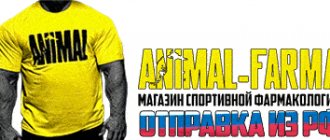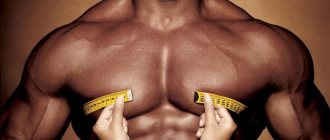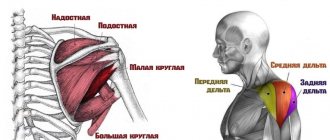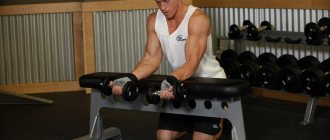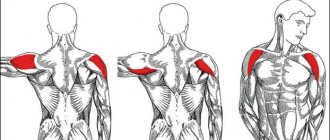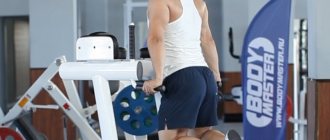Anyone who has seriously decided to take care of their body cannot do without basic knowledge of anatomy. So, in the process of working on muscles, you need to understand that they are formed by two types of fibers - fast and slow, and therefore different exercises give different effects. Fast fibers are relatively easy to build up, they are included in any high-intensity exercise.
Statodynamics in bodybuilding: exercises
The situation is different with slow fibers: their main task is long-term work and providing the body with heat. Therefore, it is more difficult to pump up these fibers during bodybuilding. This requires a special approach, for example, power static dynamics.
What is static dynamics from A to Z:
Statodynamics in bodybuilding is a training system based on performing exercises that promote the strengthening and growth of myofibrils in slow, or red, muscle fibers. The basic principles of this system are as follows:
- Exercises are performed slowly, without full extension of the limb. It is important that the main blood vessels that supply the muscle being worked remain constricted during the exercise. This will minimize the volume of oxygen supply, and intense oxidative processes will occur in the myofibrils.
- The optimal weight for the exercise is not large, about 1/3 of the athlete’s maximum single weight.
- The number of repetitions does not matter, the main thing is that after 40-60 seconds from the start of its execution (not earlier), an unbearable burning sensation appears in the muscles, which should be the reason for stopping the approach (failure). Thus, one approach lasts no more than one minute.
- The recovery pause between two sets lasts about 30–40 seconds. In total, 3–4 approaches are done per series.
- The break between episodes lasts about 10 minutes. To increase the intensity of the workout, you can work other muscle groups at this time.
If the athlete’s choice is static dynamics, the training program should be combined in such a way that during the session one muscle group is worked out , and by the next session, when the time comes to work on it again, the muscles should have already recovered. As a rule, 3-4 exercises are performed on a specific muscle group, followed by general exercises to help maintain tone. Then the training alternates again.
During the lesson, one muscle group is worked out
The training program should be combined in such a way that during the session one muscle group is worked out, and by the next session, when the time comes to work on it again, the muscles should have already recovered.
What does statistical dynamics give in general? Exercises in it will help develop general endurance, without which it is impossible to become a good bodybuilder. Plus, the development of slow fibers will ensure rapid burning of calories, which will prevent you from gaining excess fat and is especially useful during drying.
Statodynamics helps burn extra calories
Statodynamics helps develop endurance and ensures quick calorie burning.
Statodynamics and Professor Seluyanov
However, many athletes rightly note that Seluyanov did not invent the method of static dynamics, but modified one of the principles of the Golden Era of bodybuilding - the principle of constant tension. It is well known that most modern bodybuilders use it, and the combination of high-intensity repetitions with light working weights even received the now popular name - “pumping”.
The theoretical basis of static dynamics is tied to the division of all muscle fibers in the body into two subtypes:
- Glycolytic or fast muscle fibers. They are distinguished by their large size, tendency to hypertrophy, high strength and low fatigue. Their work is in demand in sports that require explosive, dynamic and short loads (fatigue sets in very quickly): strength martial arts, powerlifting, sprinting.
- Oxidative or slow muscle fibers. Their markers are low strength but low fatigue. They hypertrophy poorly, have an extensive network of capillaries, fewer myofibrils, and are actively involved in sports that require strength endurance: long-distance running, cross-fit, aerobic exercise.
Origin
The method was developed by Viktor Nikolaevich Seluyanov, professor, candidate of biological sciences.
It differs from most generally accepted schemes in bodybuilding precisely because of its scientific validity.
Here there is an understanding of the essence of what is happening inside the muscle both during the exercise and during rest between workouts (which is even more important).
Statodynamics has also been successfully tested on thousands of athletes in various sports, such as football, athletics, bodybuilding, powerlifting and others.
Until the last days of his life, Professor Seluyanov actively promoted his method, explaining its advantages and calling for its use in practice, regardless of the type of physical activity.
Working out at home: adapting isotonic training
Below are the workout plans and related videos. The classes were designed with deviations from the canons of isotonic training, but were still based on this method. So the program included classic strength exercises with a maximum range of motion. The training was built largely on a whim: some things were added intuitively. In addition, I was looking for opportunities to use home furniture as sports equipment. In any case, the training carried out is personal experience and practice, which gave an increase in vigor, good mood and a feeling of strength in the muscles.
April 1, 2020
Warm-up:
- Joint gymnastics.
- Jumping with pelvic rotation.
- Shoulders, elbows.
Coordination:
- Strikes under the step - single, “double”, “triple”.
- Site-steps with blows.
- Lying on the mat: dodges, dives, strikes.
Statodynamics (exercise duration = 30 seconds):
- Squats
- Shrugs
- Hands behind head
- Moving your arms to the right and left behind your head
- Moving your arms to the right and left in front of your chest
- Push ups
- Scissors (press)
- Gluteal bridge
April 3, 2020
Warm-up:
- Gymnastics
- Various types of strikes with defensive actions (3-5 min)
- Uppercuts - 1 round = 3 min.
- A fight with a shadow
Main part (per exercise 30-40 seconds):
- Skater - half squats on one leg
- Skater - half squats on one leg (change)
- Bath towel breaking (static)
- Push-ups with body shift to the sides
- Jumping with punches
- YTWL
- Biceps
- Leg raises from a lying position
Hitch:
- Plank (4 types)
- Stretching
April 6, 2020
Warm-up:
- Joint gymnastics
- Stretching
- Balance exercises
Main part (press):
- Sumo squats
- Push-ups with wide arms (pectoral muscles)
- Press - a cycle of 7 exercises.
Hitch:
- Stretching
- Breathing exercises
April 8, 2020
Warm-up:
- Joint gymnastics
- Stretching with a chair
- A. Moore's defense - “fold” + kick
The main part is shoulders, arms (from 30-60 seconds duration of exercises):
- Squat calf raises
- Calf raises
- Lunges
- Lunges
- Push-ups with wide arms
- Bent push-ups
- Push ups
- Towel rip
- Shadowboxing - 2 min.
Skiers and static-dynamic training
Exercises in static dynamics for skiers are also incredibly useful, as they help develop strength and endurance. Athletes are recommended to perform exactly the same exercises as runners, and the following movements can also be included in the complex:
- squats without weight;
- lunges in place;
- leg lifts while lying on your back.
It is important to perform all exercises with a shortened amplitude. If you cannot achieve a burning sensation within a minute, you can use weights, such as dumbbells.
Endurance development
A properly organized lesson contributes to a fairly rapid increase in results in various types of endurance, both strength and general.
This is explained by the fact that after 2-3 weeks of exercise, the number of mitochondria in the trained muscles increases (mitochondrial hypertrophy, already mentioned above).
Mitochondria are the energy powerhouses of muscle cells. That is, the greater their number, the higher the efficiency, and therefore the ability to perform work longer.
General principles of static-dynamic training in bodybuilding
First, let's figure out what the name “statodynamics” means.
The word “statodynamics” consists of two roots: “stato” - statics, static, and “dynamics” - dynamic. "Static" translated from Greek means "motionless." "Dynamics" - "strength, power."
In theory, these two words have opposite meanings.
Static training is training where you tense your muscles and hold them stationary under load. A typical representative of the old school who promoted static training was Alexander Zass (https://ru.wikipedia.org/wiki/Zass,_Alexander_Ivanovich). He developed his system of strengthening tendons and developing strength using static (isometric) exercises with chains.
Dynamic workouts are classic, traditional bodybuilding exercises where your muscles move and you work through a full range of motion.
Separately, everything is clear. But how can these two different approaches be combined?
Very simple!
In static-dynamic training, you hold the weight statically in the middle of the amplitude, and, at the same time, make short movements within this amplitude. That is, if you imagine, for example, an exercise such as lifting a barbell for biceps, then in the case of static-dynamic training you will hold the apparatus on your arms bent at 90 degrees, at the same time as if “swinging” its top and bottom literally a few centimeters.
Statodynamics - recommendations
However, all of the above does not mean that static dynamics is a recipe for a quick and comfortable gain of muscle mass. Here are some working recommendations for using this technique:
- Statodynamics is intended for experienced athletes who have a good feel for their body. If you are a beginner, return to this text after 2-3 years of training.
- Statodynamics are of little use for drying and losing weight. Her goals are strength development and muscle hypertrophy.
- Statodynamics shows good results for athletes with a predominance of oxidative muscle fibers. Unfortunately, this is ensured only by genetic continuity.
- There is only one accurate way to find out the predominant type of muscle fibers - a muscle biopsy. Of course, if you've spent half your life running or swimming long distances, you most likely have a predominance of slow-twitch muscle fibers. But it is not exactly.
- Another suggestion is that oxidative muscle fibers predominate in the legs. Therefore, if you are an amateur, you can practice static dynamics specifically for the leg muscles. This way, by the way, you will relieve your spine from unnecessary stress.
- Statodynamics requires strict adherence to the methodology: execution time, presence of failure, amplitude, rest. Only this way and no other way.
In conclusion, we would like to add that a scientific approach to training can diversify your work in the gym and make it more interesting and less dangerous. If you understand the biomechanics of exercise, maintain a balanced diet (by the way, there are excellent food delivery services - for example Grow Food) and are looking for harmony between the result and extreme loads, then you can easily use training in the static-dynamic style.
Read our other articles on fitness and sports and stay fit.
If you want to be more effective not only in sports, read our material on multitasking.
Statodynamic exercises
When using the technique, the question of correct selection of exercises immediately arises.
Most strength movements are suitable for training in this mode .
The author himself said that it is preferable to perform them on blocks and simulators, since with such equipment it is easier to achieve and control constant muscle tension.
However, this is not a fundamental rule. And in practice, results are achieved using movements with your own body weight, or with extremely light weights in the form of a barbell and dumbbells.
Advantages and disadvantages
Among the advantages are noted:
- Scientificity
It was developed on the basis of a research institute, where many experiments were initially carried out. The scheme was then tested on volunteers. And only after that is it recommended for use.
- Virtually zero risk of injury
Since there are either no working weights (working with your own body weight), or light weights are used (10-40% of 1RM).
- Highly effective for hypertrophy of slow fibers, local fat burning and increased endurance
- Versatility
Suitable for solving various, sometimes opposing training goals.
However, static dynamics has a number of disadvantages:
- Difficult to understand for most people
The scientific basis of the loads played a cruel joke on the methodology. To understand it, you need to have at least an average understanding of the basics of biochemistry, physiology and anatomy.
The author was unable or did not have time to adapt the explanation for a wide range of users without special knowledge.
This makes it difficult to understand and slows down the spread of the lesson plan.
- Lack of integrity and completeness
The author himself noted that the methodology is constantly being improved and improved on the basis of new accumulated practical results.
This explains some of the contradictions in the load diagram according to this principle. After all, the articles and lectures of Professor Seluyanov, which are on the Internet, are from different years.
To avoid misunderstandings, it is wise to use the latest information on this topic as a source of information.
- Practice has shown that the static-dynamic mode is inferior to traditional strength methods in terms of developing the level of strength


